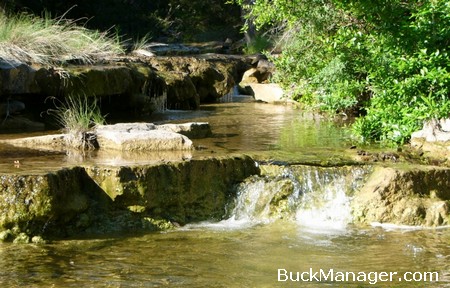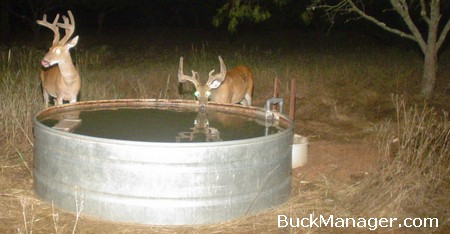Whitetail Water Needs
How much water do white-tailed deer drink? How much do they need on a daily basis? The high temperatures experienced during the “dog days” of summer are brutal. We have to drink more water. Also, it makes hunters ponder white-tailed deer water requirements. Can deer find enough water on your property to survive? It’s a simple question, but an important one to consider when it comes to deer management and future deer hunting on a property.
Water requirements generally vary with available food sources, climactic conditions and a whitetail’s physiological state. For example, deer that are lactating or growing need more water than deer that are not.

Whitetail are not picky when it comes to water sources. They will readily use troughs, ponds, creeks, rivers springs, dew, snow and even mud puddles. In fact, secluded depressions that hold water for any period of time will be used heavily by deer. These tucked-away surface sites allow does with fawns and weary bucks to go about their business in seclusion. This may decrease their chances of being detected by predators and hunters.
Next time you stumble across one of these mud holes pay attention. Take a look at the number of deer tracks around them. Deer have no problem using water from where they can get it. And they can get it in many ways.
Daily Deer Water Requirements
White-tailed deer require water but can go for relatively long periods of time without it. Deer use water daily. They can ingest it directly or they can extract it from their diet if succulent plants are available to them. In areas where water-rich foods are lacking, the rule of thumb is that at least one source of permanent water per square mile is needed. This will ensure use of the available area, assuming the area is deer habitat.
The home range of a whitetail deer generally ranges from 400 to 800 acres. So, it’s a good idea to have at least one water source per square mile. This offers at least one watering site and will meet deer water requirements for the animals living in the area. Lack of free water on dry ridges may deter deer from using these areas.
Water Distribution for Deer
Many factors affecting how much water a whitetail deer drinks each day. These factors also impact seasonal consumption. It’s difficult to say that “Rancho Perfecto” needs exactly 5 ponds or exactly 6 troughs scattered across it. However, I recommend developing watering sites no less than one mile apart. Doing this means no deer is ever more than a half mile from water at any time. This also falls in line with the “at least one water source per square mile” philosophy mentioned earlier. It ensures the whitetail deer in your area have access to surface water even if they do not necessarily need it.
Meeting Deer Water Requirements
Deer use water in several forms. In addition to the liquid found on the earth’s surface, whitetail deer can use preformed water and metabolic water. Preformed water is the stuff that is found in the foods that they eat. Metabolic water is produced internally as a result of hydrogen oxidation during an animal’s metabolic processes. Much of the water that whitetail deer need can be found in the food that they eat. Most of these foods are between 50 and 90 percent water. No need to go hunting for water when high quality, natural food sources are abundant. In essence, deer only drink water to supplement the water they extract from their diet.
One study in the Southeastern U.S. suggested that whitetail do not require surface water on a daily basis because of high rainfall, humidity, and the availability of succulent plants. Researchers said this applied for at least most of the year. Additionally, the study mentioned that surface water may be important during the summer when rainfall is scarce. This is also when the water requirements of lactating does are high.

A white-tailed deer needs about 1 1/2 quarts of water for every 100 pounds of body weight per day during the winter. This requirement doubles for deer during the summer. When temperatures rise, deer need about 3 quarts for every 100 pounds of body weight. How many deer are in your area? How much do the deer using your property weigh?
The volume of water is even greater for does that are supporting fawns or deer found in more arid regions, such as West or South Texas. Again, this does not mean that a deer will necessarily drink this amount of water, but that they will supplement the preformed and metabolic water taken from their diet with surface water.
Water is Life
It’s thought that during times of drought or pregnancy that surface water is a definite necessity. It’s believed that whitetail actually ingest between 2-3 times as much water as food. Is this the case always? Don’t know. There can be other factors that increase water intake, too. The supplemental feeding of deer with protein pellets is also believed to elevate whitetail deer water requirements.
Deer that do not have access to adequate amounts of water will not forage. This would put a damper on any deer management efforts in a hurry. In addition, this would hurt the deer hunting, or lack thereof, on a property as well. Deer that do not eat will not maintain good body condition, raise fawns, grow large antlers, or live.
As mentioned, habitat conditions do come into play. Moisture-rich plants can provide much of the water that deer may need. However, this is not the case in areas experiencing drought conditions or for whitetail deer living in semi-desert conditions. Although surface water is not as important to whitetails as food or habitat with suitable cover, a lack of available water can prevent animals from using an area in drier climates.
Got Water?
Whitetail are like all living things in that they require water in order to survive. Deer water requirements will vary based on whether they are growing body mass or simply in maintenance mode. The amount required daily varies seasonally. Deer require much more water during the summer. This is especially true for does which need more liquid for milk production.
Tale a closer look at your property if you even think water may be a limiting factor. The deer and other wildlife found in the area will appreciate it. The installation of additional tanks or water troughs will more than likely help your population management efforts. This potentially leads to improved deer hunting in the area. A study that took place in Texas reported that watering sites are frequently the centers of whitetail home ranges. Makes sense.
How long can a deer go without water?
Junior, a good question that lacks an easy answer. A deer’s water needs really depends on the time of year, the availability of forage, the age of the deer, and whether its a buck or doe (which could be pregnant or even lactating). A doe with fawns during the summer would require a lot of water compared to a buck in the middle of the spring season.
Since deer obtain a good percentage of their water requirement from food, I’d suggest that food availability and ambient temperature would generally be the most important factors.